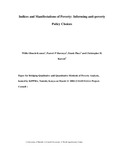| dc.description.abstract | Kenya has entered the 21st century with over 50% of its population classified as
absolutely poor in that they live on less than a dollar a day. Per capita income is lower
than at the end of the 1960’s. Income, assets, and access to essential services are
unequally distributed. The country has made important economic reforms, improving
macroeconomic management, liberalizing markets and trade, and widening the scope for
private sector activity in the hope of improving economic growth and welfare for
Kenyans. Yet, despite these reforms the country has experienced little growth and
poverty continues to afflict an ever-larger segment of its citizenry, especially in rural
areas.
Recent debate on the reasons for limited impact of economic reforms on poverty
reduction has been of a “top-down’ nature, where analysts consider a policy reform as an
external shock and ask how its benefits and costs work their way through the economy to
the poor. Increasingly, researchers are recognizing that macroeconomic and sectoral
issues are only part of the basis for growth and poverty reduction. What is missing is a
“bottom-up” perspective, which starts from the capabilities of individuals, households,
and communities. What are their productivities, their environment and how do economic
and social developments play out on the ground and how can these developments be
influenced?
Poverty is a complex, multifaceted concept reflecting a low level of well-being (World
Bank 2000). The human well being itself is a multidimensional continuum from extreme
deprivation (poverty) to a high attainment or experience of standard of living.
2
In economics use is commonly made of income or expenditure flows as proxies for
welfare. This approach is appropriately contested within the social sciences, since well
being is experiential, value laden, context and situation dependent and reflects social and
personal factors. Poverty is therefore more than lack of material needs, since material
sufficiency alone does not guarantee well being. While measurement of poverty is a
critical empirical and policy concern, an important phenomenon that has gained currency
in recent work on poverty analysis is that of poverty dynamics and poverty traps: who
climbs above it, descends below it or oscillates around it – because poverty dynamics is
the more fundamental policy concern. Identifying the right policy mix to help a given poor subpopulation depend on an accurate understanding of rural poverty dynamics. | en |

